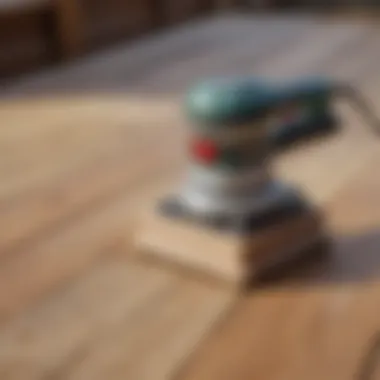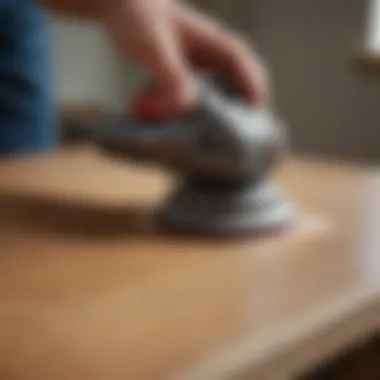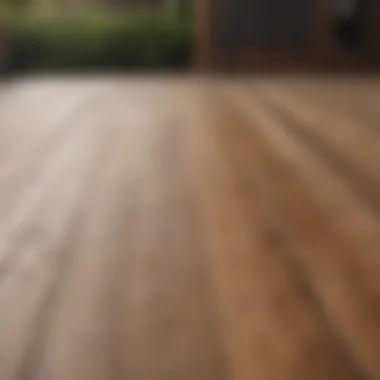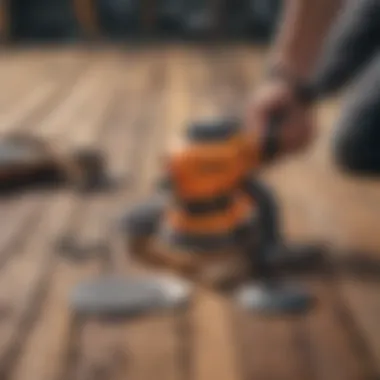Sanding Your Deck with an Orbital Sander Guide


Intro
Maintaining a beautiful deck is vital for enhancing the overall aesthetics of your outdoor space. One of the most effective methods for achieving a smooth surface is sanding with an orbital sander. This tool provides an efficient way to remove imperfections and prepare the wood for sealing or staining. This comprehensive guide will help you navigate through the necessary steps of sanding your deck, ensuring a well-prepared surface to enhance its longevity.
Users, whether you are an experienced homeowner or just beginning your adventure in deck maintenance, will find this guide informative. Let’s dive into the essential elements that will aid in your sanding project.
Intro to Deck Maintenance
Maintaining a deck is essential for preserving its beauty and structural integrity. Over time, exposure to weather elements can lead to fading, splintering, and a variety of other damages. Regular maintenance ensures that your outdoor space remains inviting and functional. Homeowners should consider deck maintenance as not just an aesthetic choice, but as a necessary investment in property value. A well-maintained deck can enhance the outdoor experience, making it a preferred gathering spot for friends and family.
Importance of Deck Maintenance
Deck maintenance involves various tasks that contribute to the durability and appearance of the structure. Addressing issues like wood rot or peeling paint can prevent more significant problems in the future. Ignoring these concerns may lead to costly repairs or even a complete deck replacement. Furthermore, regular maintenance increases safety for everyone who uses the deck, reducing the risk of injuries due to splinters or unstable boards. Investing time into caring for a deck can improve its longevity, ultimately saving homeowners money while enhancing curb appeal.
Overview of Sanding Techniques
Sanding plays a critical role in deck maintenance. This process not only removes old finishes and imperfections but also prepares the wood for sealing or staining. Among the methods, orbital sanding is particularly beneficial. It provides a smoother finish compared to traditional sanding methods. There are different techniques, such as random orbital sanding and square orbital sanding. Each has its advantages depending on the type of surface and desired finish.
Choosing the right sanding technique is essential for achieving the best results. Understanding the specifics of each method allows homeowners to select what best suits their needs and skill levels. Proper sanding is a foundation for further treatment and can ultimately dictate the performance of any additional finishes applied.
Understanding the Orbital Sander
Understanding the orbital sander is crucial for anyone interested in accomplishing effective deck maintenance. This tool is not only commonly used but also highly efficient in preparing surfaces for finishing. Knowing its features, types, and functions can greatly influence the quality of your sanding job and, ultimately, the durability and appearance of your deck.
What is an Orbital Sander?
An orbital sander is a power tool designed for sanding wood surfaces. It uses a circular sanding pad that moves in small, circular motions. This rotational motion helps in smoothing and finishing wood surfaces without leaving swirl marks, which is essential for an even finish. Orbital sanders are user-friendly and suitable for both inexperienced users and seasoned professionals in woodworking and home improvement.
Types of Orbital Sanders
Random Orbital Sanders
Random orbital sanders stand out due to their dual-action mechanism. They not only rotate around a fixed center but also move in an elliptical pattern. This unique action minimizes the risk of producing scratches or circular marks on the surface, making them highly advantageous for achieving a flawless finish. They are a popular choice for numerous sanding tasks, especially deck sanding, where a smooth surface is paramount.
One of the key advantages of random orbital sanders is their versatility. They can handle a variety of materials and are effective for both rough sanding and the final finish sanding. However, there are some disadvantages. They can be heavier than other models and may require more effort to operate effectively over long periods.
Square Orbital Sanders
Square orbital sanders, often known as detail sanders, are specifically designed for sanding in tight corners and intricate details. Their square shape allows users to sand edges and corners without the worry of missing patches. For those working in circumstances where precision is necessary, square orbital sanders can be exceptionally beneficial.
However, they have limitations. While they excel in detail work, they may not be as efficient for larger surface areas when compared to random orbital sanders. Their smaller sanding pads can require more time to cover extensive areas, which can slow down the overall sanding process.
Choosing the Right Orbital Sander for Your Deck
Selecting the right orbital sander for deck sanding is vital. The choice between a random orbital sander and a square orbital sander largely depends on your specific project needs. For general deck maintenance that requires speed and efficiency over large areas, a random orbital sander is often preferred. On the other hand, if your deck has intricate railings or detailed woodworking, a square orbital sander can be advantageous.


When making your decision, consider the following factors:
- Material Type: Consider the type of wood or other materials involved.
- Deck Condition: Evaluate if your deck is heavily weathered or requires just a touch-up.
- Personal Experience: Choose a tool that matches your skill level and comfort.
Essential Tools and Materials
When it comes to sanding your deck effectively, having the right tools and materials at hand is crucial. Utilizing the correct equipment not only enhances the quality of the finish but also ensures your safety during the process. The tools and supplies required vary based on the deck's existing condition and your level of experience. Familiarizing yourself with these essentials allows for a smoother and more efficient sanding experience.
Required Tools for Sanding
Orbital Sander
An orbital sander is essential for achieving a smooth surface on your deck. This tool works by moving the sanding disc in a circular motion, allowing for even sanding without leaving marks. One key characteristic of orbital sanders is their versatility; they can be used on various surfaces including wood and composites.
An orbital sander is often preferred because it reduces the risk of sanding too deeply, which can damage the wood. The unique feature of a random orbital sander is its dual motion, which eliminates swirling patterns. However, it may take more time to complete larger areas compared to other sanders. Overall, the effectiveness and quality of the finish make the orbital sander a popular choice for deck sanding.
Sanding Discs
Sanding discs are an equally important component in the sanding process. They come in various grits, which indicate the roughness of the surface they can handle. Choosing the right grit for your job is essential. Coarser grits will remove material faster but can lead to scratches if not followed by finer grits.
The key characteristic of sanding discs is their compatibility with specific orbital sanders. Different brands and types may require specific discs to function correctly. A unique feature is their ability to be easily changed during the sanding process, allowing for seamless transitions between different grits. The disadvantage may arise with lower-quality discs, which can wear out quickly and may not provide the desired finish.
Safety Gear
Safety gear is a fundamental aspect when sanding a deck. Sanding creates dust particles that can be harmful when inhaled. This aspect emphasizes the importance of wearing appropriate safety equipment, like masks and goggles. The key characteristic of safety gear is that it protects your respiratory system and eyes from airborne particles. This equipment not only safeguards your health but also enhances your overall experience by allowing you to work without discomfort.
A unique feature of modern safety gear is the availability of reusable and adjustable options, increasing comfort during long sanding sessions. Neglecting safety gear could lead to potential health issues or injuries, making it a necessary investment for any sanding project.
Additional Supplies
Deck Cleaner
Deck cleaner is vital for preparing the surface before sanding. This product is designed to remove dirt, mildew, and old finishes, allowing the sander to work effectively. The key characteristic of deck cleaners is their formulation, which often includes compounds that break down tough grime. Using a good deck cleaner enhances the overall sanding process by ensuring a clean surface, which leads to a better final finish.
One unique feature to note is that different cleaners target specific problems, such as mold or stains. However, caution should be exercised with cleaners that may be too harsh on wood; they can cause damage if misused. Therefore, selecting a quality cleaner is essential.
Wood Sealant
Wood sealant plays an important role after sanding. It protects the wood from moisture and UV damage, prolonging the life of your deck. The key characteristic of wood sealants is their ability to penetrate the wood, forming a barrier against elements. This type of product often enhances the natural appearance of wood, preserving its aesthetic appeal.
Wood sealants come in various formulations, including water-based and oil-based options. Each has its unique advantages and disadvantages. For instance, water-based sealants dry quickly, but they may require more frequent reapplication, whereas oil-based products offer long-lasting protection but take longer to dry. The right sealant choice will depend on your specific needs and the climate conditions in your area.
In summary, understanding the essential tools and materials you need is fundamental to achieving a successful sanding experience. From the right orbital sander to proper safety gear, each element contributes to a safer and more effective process.
Preparing Your Deck for Sanding
Preparing your deck before sanding is a crucial step that cannot be overlooked. A well-prepared surface ensures that your sanding process is efficient and yields a smooth, even finish. Additionally, it helps mitigate issues that could arise later, such as uneven wear or degradation of the wood.


Inspecting the Deck
Before you even consider sanding, start by inspecting the deck closely. Take the time to check for any signs of damage, such as water stains, warping, or splinters. These factors not only affect the deck's appearance but also its longevity.
Look out for loose boards and protruding nails or screws. It may be necessary to replace damaged boards prior to sanding. Identifying these issues early allows you to address them, avoiding complications during the sanding process.
Cleaning the Deck Surface
Once inspection is complete, focus on cleaning the deck surface. This step is vital to remove dirt, mold, and any residue that can interfere with the sanding. Use a broom to sweep away debris. For stubborn stains, a mixture of warm water and deck cleaner can be used. Apply it with a brush or a mop, ensuring you cover the entire surface thoroughly.
Allow the deck to dry completely before proceeding to the sanding step. A dry surface will greatly improve the efficiency of the orbital sander and help achieve a better finish.
Removing Furniture and Obstacles
Lastly, it is important to remove all furniture and obstacles from the deck prior to starting the sanding process. This allows you free movement and unhindered access to all areas of the deck. Move planters, furniture, and decorative items out of the way. Mark any sections that are difficult to access for later attention.
Preventing potential damage to these items is another benefit of clearing the area. This thoughtful preparation enhances your sanding experience and ensures you can focus on achieving a professional finish.
Techniques for Sanding with an Orbital Sander
Sanding your deck is an essential aspect of maintaining its appearance and durability. Proper techniques for sanding with an orbital sander can significantly enhance the quality of the finish you achieve. This section will discuss key processes, their importance, and some considerations to keep in mind. The right methods eliminate surface imperfections and contribute to the longevity of your outdoor space.
Proper Sanding Techniques
To start, maintain a consistent speed when using the sander. A slower pace affords better control, while moving too fast might miss spots. It’s essential to keep the sander flat against the surface to avoid gouging the wood. Instead of applying excessive pressure, let the sander do the work. Always sand in the direction of the wood grain for best results.
Moreover, before you begin, make sure to use the proper grit sandpaper. Start with a lower grit, such as 60 or 80, to remove old finishes or rough spots. Transition to a higher grit, like 120 or 150, to achieve a smooth finish. Switching grits ensures that the wood's surface is well-prepared for any sealant or stain you may apply later.
Achieving a Consistent Finish
Achieving a consistent finish requires a combination of technique and attention to detail. First, overlap your sanding passes by about half the diameter of the sanding pad. This method helps to avoid streaks or missed spots that can happen with a more scattershot approach. The goal is to create uniformity in texture and depth.
It’s advisable to change out the sanding disk when it shows signs of wear. A worn disk cannot effectively sand the wood, resulting in uneven surfaces. Also, regularly check the surface for areas that may require extra attention. If you notice any uneven spots, focus your efforts there until the surface appears uniform.
"Attention to detail during sanding often determines the final quality of your deck's look."
Common Mistakes to Avoid
There are several common pitfalls to be aware of while sanding your deck. One of the most significant errors is neglecting to inspect the wood before beginning. Cracks or loose deck boards should be addressed; otherwise, sanding may worsen these issues.
Another mistake is sanding too aggressively, which can lead to deep grooves in the wood. Always remember that patience is key. Short, gentle passes are more effective than pressing too hard, which can ruin the surface.
Lastly, many homeowners rush the process of changing grits. Transitioning too soon can leave the wood exposed with scratches from the lower grit. Each step is critical to achieving that desirable smooth finish.
Post-Sanding Care
Post-sanding care is vital for ensuring that the deck maintains its newly achieved finish and durability. After the strenuous process of sanding, the raw surface of the wood requires attention to maximize its performance and visual appeal. Ignoring this step can lead to premature wear, exposure to elements, or uneven staining.


Inspecting the Sanded Surface
Once sanding is complete, take a moment to closely inspect the surface. Look for any imperfections that may have been missed during the sanding process. Check for uneven spots, scratches, or areas where the old finish may still exist. Using a bright light can help illuminate these details. This inspection is crucial as it dictates the next steps. If defects are found, additional sanding may be necessary. A thorough inspection ensures a flawless application of any finishes or sealants that follow.
Applying Wood Finish or Sealant
After confirming that the surface is satisfactory, it’s time to apply a wood finish or sealant. This step is significant for preserving the wood against moisture, UV rays, and general wear. Choose a finish that complements the deck's style but also offers protection.
- Oil-based finishes provide a rich appearance but may take longer to dry.
- Water-based finishes dry faster and contain fewer volatile organic compounds, making them a greener option.
Before applying the finish, ensure that the surface is completely clean and dry. Using a brush or roller, apply a thin coat of the chosen finish. Follow the manufacturer’s instructions regarding drying times and the number of coats required. Applying a protective layer not only enhances the wood's beauty but also adds years of life to your deck.
Final Cleanup
Cleanup after sanding and finishing is often overlooked, yet it is an integral part of the process. Begin by removing any sawdust and debris from the deck’s surface. Use a shop vacuum for efficiency. Ensuring the area is clear will prevent any contaminants from marring the new finish. Dispose of used materials properly, especially sanding discs or rags with finish remains, as they can be flammable.
To maintain cleanliness in the workspace, it is also advisable to clean the tools used during sanding and finishing. Proper maintenance of tools extends their lifespan and enhances performance in future projects.
Maintaining a Sanded Deck
Maintaining a sanded deck is crucial for ensuring its longevity and aesthetic appeal. It is not enough to sand and finish the deck once; ongoing care is essential. Regular maintenance not only preserves the look of your deck but also prevents damage from environmental factors such as moisture, sunlight, and temperature changes. For homeowners, knowing how to keep their sanded deck in good condition can save time and money in the long run.
One of the most significant benefits of maintaining your sanded deck is that it helps to uphold the value of your property. A well-maintained deck can enhance outdoor enjoyment and increase the overall appeal of a home. Additionally, a maintained deck reduces the risk of injury due to cracked or warped wood.
Regular Cleaning Practices
Cleanliness should be a priority for any sanded deck. Regular cleaning helps prevent the buildup of dirt, grime, and debris that can harm the wood over time. To maintain cleanliness, consider the following practices:
- Sweep Regularly: Use a broom to sweep away leaves and other debris. This step should be done frequently, especially in fall and spring.
- Wash with Water: Use water to rinse the deck every few weeks. A gentle spray with a hose is often sufficient. For tougher stains, mild soap may be applied.
- Inspect for Mold or Mildew: Look for signs of mold or mildew, particularly in shaded areas. If detected, clean these spots using a mixture of water and vinegar.
- Remove Furniture: Occasionally, moving patio furniture and other items can help get rid of hidden dirt and avoid discoloration of the wood beneath.
In addition, it is beneficial to apply a wood cleaner tailored for outdoor surfaces at least once or twice a year. This method will maintain the wood’s natural color and integrity.
Re-sanding and Maintenance Schedule
A regular maintenance schedule is key for a sanded deck. Over time, foot traffic, weather conditions, and other external factors will wear down the finish of the wood. A strategic plan helps ensure the deck remains in optimal condition. Here are some tips to consider:
- Annual Inspection: Look for signs of wear, such as splintering or discoloration. This inspection will guide your decision on whether a re-sanding is necessary.
- Every Two to Three Years: It is often recommended to re-sand the deck surface every two to three years. This timeframe might vary based on the deck type and environmental conditions.
- Sealing: After re-sanding, apply a wood sealant. This layer protects against moisture and UV damage, ultimately extending the life of the deck.
- Weather Considerations: Be sure to choose dry seasons for sanding and sealing. Moisture can hinder proper sealing, leading to issues down the line.
By adhering to these practices, your sanded deck can remain a functional and attractive space for years to come. Maintaining a sanded deck requires commitment; however, the rewards of an enduring and beautiful deck make it well worth the effort.
Epilogue
In concluding this comprehensive guide on sanding your deck, it’s crucial to recognize the significance of each segment discussed. The process of sanding is not merely about enhancing the aesthetic appeal of your deck; it also plays a vital role in preparing the surface for further treatments and extending the life of the wood. Regular maintenance can help prevent rot, splinters, and degradation, ensuring that your outdoor space remains safe and inviting.
Summary of Key Points
- Preparation is Essential: Before beginning the sanding process, a meticulous preparation phase is vital. Inspecting the deck for damage, clearing the surface, and thoroughly cleaning are foundational steps that set the stage for effective sanding.
- Understanding Your Tools: Knowledge of different types of orbital sanders and knowing how to choose the right one for your needs is paramount. Familiarity with the tools enhances efficiency and effectiveness.
- Proper Techniques Matter: Employing correct sanding techniques ensures a uniform finish. Awareness of common mistakes can help you avoid pitfalls that may compromise the results.
- Post-Sanding Care: After the sanding is completed, inspecting the surface and applying protective finishes are critical for safeguarding your investment.
- Regular Maintenance: Incorporating regular cleaning and re-sanding into your routine maintenance plan will prolong the life of your deck and improve its appearance over time.
Encouragement for DIY Maintenance
Embracing the role of a DIY enthusiast when it comes to deck maintenance is empowering. The skills gained through hands-on experience not only lead to a greater appreciation of your outdoor areas but also enhances your ability to make informed decisions about maintenance and repair. Remember, investing time to learn about sanding techniques and other upkeep procedures pays off in the long run.
Your deck is an extension of your home, and maintaining it is an investment in both appearance and function. Engage with your outdoor space and take pride in caring for your deck. The satisfaction that accompanies completing projects yourself cannot be understated. You are capable and resourceful, and with thorough preparation and understanding, you can achieve remarkable results with minimal professional assistance.



